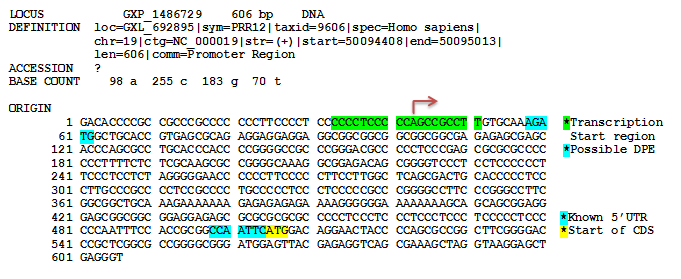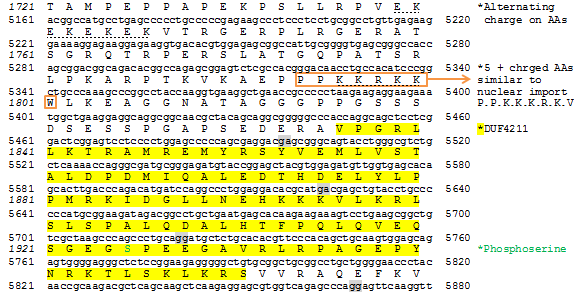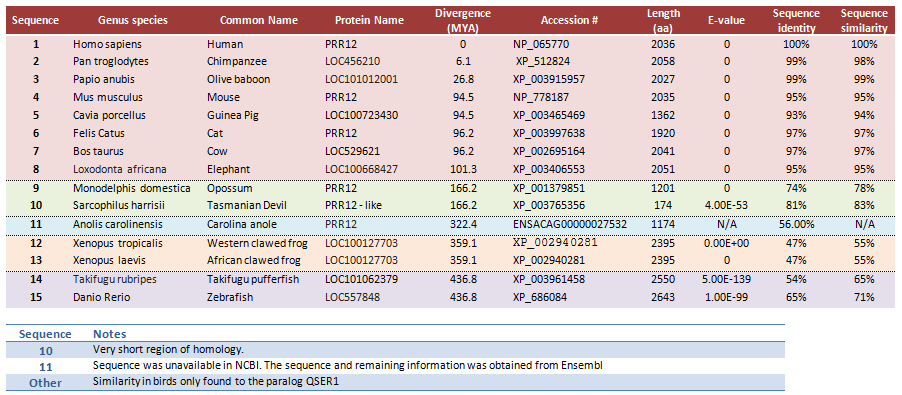Proline-rich 12 on:
[Wikipedia]
[Google]
[Amazon]
Proline-rich 12 (PRR12) is a





protein
Proteins are large biomolecules and macromolecules that comprise one or more long chains of amino acid residue (biochemistry), residues. Proteins perform a vast array of functions within organisms, including Enzyme catalysis, catalysing metab ...
of unknown function encoded by the gene
In biology, the word gene has two meanings. The Mendelian gene is a basic unit of heredity. The molecular gene is a sequence of nucleotides in DNA that is transcribed to produce a functional RNA. There are two types of molecular genes: protei ...
''PRR12''.
Gene
The ''Homo sapiens'' ''PRR12'' gene is 34,785 base pairs long, contains 14exons
An exon is any part of a gene that will form a part of the final mature RNA produced by that gene after introns have been removed by RNA splicing. The term ''exon'' refers to both the DNA sequence within a gene and to the corresponding sequence i ...
, and is located on chromosome 19
Chromosome 19 is one of the 23 pairs of chromosomes in humans. People normally have two copies of this chromosome. Chromosome 19 spans more than 61.7 million base pairs, the building material of DNA. It is considered the most Gene density, gene-ri ...
at 19q13.33. Known aliases for PRR12 include "proline rich 12" and KIAA1205. Within its gene neighborhood, ''PRR12'' is flanked by ''PRRG2'' and ''SCAF1'' on the sense strand and ''RRAS
Ras-related protein R-Ras is a protein that in humans is encoded by the ''RRAS'' gene.
Interactions
RRAS has been shown to interact with:
* ARAF,
* Bcl-2,
* NCK1
Cytoplasmic protein NCK1 is a protein that in humans is encoded by the ...
'' and '' NOSIP'' on the antisense strand. Nitric oxide synthase interacting protein, NOSIP, regulates the activity and localization of nitric oxide synthase (endothelial and neuronal), controlling nitric oxide
Nitric oxide (nitrogen oxide, nitrogen monooxide, or nitrogen monoxide) is a colorless gas with the formula . It is one of the principal oxides of nitrogen. Nitric oxide is a free radical: it has an unpaired electron, which is sometimes den ...
production. Proline rich Gla, PRRG2, has a Gla domain
Vitamin K-dependent carboxylation/gamma-carboxyglutamic (GLA) domain is a protein domain that contains post-translational modifications of many glutamate residues by vitamin K-dependent carboxylation to form γ-carboxyglutamate (Gla). Proteins wit ...
which binds hyaluronan
Hyaluronic acid (; abbreviated HA; conjugate acid, conjugate base hyaluronate), also called hyaluronan, is an anion#Anions and cations, anionic, Sulfation, nonsulfated glycosaminoglycan distributed widely throughout connective tissue, connective ...
and is associated with proteins present in the ''extracellular matrix'' involved with cell adhesion and cell migration. Ras-related protein R-Ras, RRAS, belongs to the Ras family and is involved in the organization of actin filaments within the cytoskeleton. SR-Related CTD-Associated Factor 1, SCAF1, is thought to be involved in the splicing of precursor mRNA
Precursor or Precursors may refer to:
*Precursor (religion), a forerunner, predecessor
** The Precursor, John the Baptist
Science and technology
* Precursor (bird), hypothesized genus of fossil birds that was composed of fossilized parts of unrel ...
.
Promoter
The promoter region of PRR12 was predicted using ElDorado at Genomatix. The region starts at position 50094408 and ends at 50095013 of chromosome 19. This promoter set is conserved in the macaque, mouse, rat, horse, cow, pig, dog and zebrafish. No recognizable TATA box, B recognition element (BRE), or CAAT box was found upstream of the predicted transcription start region. Because no clear TATA box was found, it is possible that PRR12 is regulated by a TATA-less promoter containing a downstream promoter element (DPE). However, the predicted DPE is only 15bp downstream of the transcription start region instead of the typical +25 to +32 base pairs. More research will be required to expand the 5' UTR of the PRR12 transcript in order to confirm where the correct promoter region is located.

Transcript
mRNA sequence The PRR12 mRNA transcript is 6960 base pairs long and contains several short sequence repeats. The ''Homo sapiens'' PRR12 has threeisoforms
A protein isoform, or "protein variant", is a member of a set of highly similar proteins that originate from a single gene and are the result of genetic differences. While many perform the same or similar biological roles, some isoforms have uniqu ...
with isoform 3 containing roughly one thousand more amino acid residues than the other isoforms. No 5' UTR is given in the NCBI records for the ''Homo sapiens'' PRR12 transcript. However, 7 base pairs of the 5' UTR have been determined in the ''Papio anubis'' ortholog. The 3' UTR is 852 base pairs long.

Expression
The gene is moderately expressed at even levels in a wide variety of tissue types.Protein
The PRR12 transcript encodes a protein that is 2036 residues long. It has amolecular weight
A molecule is a group of two or more atoms that are held together by Force, attractive forces known as chemical bonds; depending on context, the term may or may not include ions that satisfy this criterion. In quantum physics, organic chemi ...
of 211.1 kdal and an isoelectric point
The isoelectric point (pI, pH(I), IEP), is the pH at which a molecule carries no net electric charge, electrical charge or is electrically neutral in the statistical mean. The standard nomenclature to represent the isoelectric point is pH(I). Howe ...
around 7.728.http://seqtool.sdsc.edu/CGI/BW.cgi#! A number of bioinformatics databases have also predicted PRR12 to be a soluble protein with no transmembrane domains
A transmembrane domain (TMD, TM domain) is a membrane-spanning protein domain. TMDs may consist of one or several alpha-helices or a transmembrane beta barrel. Because the interior of the lipid bilayer is hydrophobic, the amino acid residues in ...
.
Jianping Chen lists PRR12 as an "extremely vulnerable protein". These proteins have regions rich in amino acids that are "poor protectors" of hydrogen bonds
In chemistry, a hydrogen bond (H-bond) is a specific type of molecular interaction that exhibits partial covalent character and cannot be described as a purely electrostatic force. It occurs when a hydrogen (H) atom, covalently bonded to a mo ...
along the backbone of the protein, inhibiting the ability of these proteins to fold properly and allowing the possibility of protein aggregation. Residues such as G, A, S, Y, and P are listed as poor protectors and PRR12 is rich in both proline and glycine. Many of the proline residues are positioned consecutively in regions of low complexity. These regions may give this protein interesting secondary structure as a cluster of proline can form a polyproline helix
A polyproline helix is a type of protein secondary structure which occurs in proteins comprising repeating proline residues. A left-handed polyproline II helix (PPII, poly-Pro II, κ-helix) is formed when sequential residues all adopt (φ,ψ) backb ...
.
PRR12 contains a possible nuclear import signal starting at P1794. A typical nuclear localization sequence
A nuclear localization signal ''or'' sequence (NLS) is an amino acid sequence that 'tags' a protein for import into the cell nucleus by nuclear transport. Typically, this signal consists of one or more short sequences of positively charged lysines ...
would have the following residues: P-P-K-K-K-R-K-V. PRR12 contains a DUF4211 domain starting at V1836 that shows homology to the pfam13926 domain. This domain is well conserved in PRR12 orthologs
Sequence homology is the biological homology between DNA, RNA, or protein sequences, defined in terms of shared ancestry in the evolutionary history of life. Two segments of DNA can have shared ancestry because of three phenomena: either a spec ...
. PRR12 also contains well conserved AT-hook
The second AT-hook of HMGA1 (black ribbon) bound to the minor-groove of AT-rich DNA. The amino-acid side chains and nucleotides have been hidden.
The AT-hook is a DNA-binding motif present in many proteins, including the high mobility group ( ...
binding regions at P1168 and G1202. These regions allow proteins to bind DNA, further supporting the localization of PRR12 to the nucleus.
Conservation
Paralogs
The glutamine and serine-rich protein 1 ( QSER1) is the only closely related paralog to PRR12 (NCBI accession: EAW68214). QSER1 has no known function and, like PRR12, it contains DUF4211 and a nuclear localization signal. QSER1 does not contain the AT binding regions or Epstein-Barr virus antigen that is found in PRR12.Orthologs
The most distant relative found through BLAST with a significant similarity to PRR12 is the fish ''Danio rerio''. Orthologs were found in fish, amphibians, reptiles, and other mammals. While no PRR12 orthologs were found in birds, birds did have orthologs to the QSER1, which is a closeparalog
Sequence homology is the biological homology between DNA, RNA, or protein sequences, defined in terms of shared ancestry in the evolutionary history of life. Two segments of DNA can have shared ancestry because of three phenomena: either a sp ...
to human PRR12.


Clinical importance
One study on theEpstein–Barr virus
The Epstein–Barr virus (EBV), also known as human herpesvirus 4 (HHV-4), is one of the nine known Herpesviridae#Human herpesvirus types, human herpesvirus types in the Herpesviridae, herpes family, and is one of the most common viruses in ...
found close homology between a proline rich region in PRR12 and a 65 amino acid long region at the terminal end of EBNA-2 (a nuclear antigen of the virus). This Epstein-Barr virus antigen is associated with autoimmune systemic connective tissue diseases
Connective tissue diseases (also termed connective tissue disorders, or collagen vascular diseases), are medical conditions that affect connective tissue.
Connective tissues protect, support, and provide structure for the body's other tissues a ...
(CTD) including systemic lupus erythematosus
Lupus, formally called systemic lupus erythematosus (SLE), is an autoimmune disease in which the body's immune system mistakenly attacks healthy tissue in many parts of the body. Symptoms vary among people and may be mild to severe. Common ...
(SLE), primary Sjögren syndrome Sjögren is a Swedish surname. Notable people with the surname include:
* Anders Johan Sjögren (1794–1855), Finnish linguist, historian, ethnographer and explorer
* Ann Mari Sjögren, Swedish fantasy artist and illustrator
* Christer Sjögren, ...
(SS), rheumatoid arthritis
Rheumatoid arthritis (RA) is a long-term autoimmune disorder that primarily affects synovial joint, joints. It typically results in warm, swollen, and painful joints. Pain and stiffness often worsen following rest. Most commonly, the wrist and h ...
(RA), systemic sclerosis
Systemic scleroderma, or systemic sclerosis, is an autoimmune rheumatic disease characterised by excessive production and accumulation of collagen, called fibrosis, in the skin and internal organs and by injuries to small arteries. There are tw ...
(SSc), and secondary SS. PRR12 is not only proline rich, but it is also rich in glycine, suggesting that there might be a relationship to collagen
Collagen () is the main structural protein in the extracellular matrix of the connective tissues of many animals. It is the most abundant protein in mammals, making up 25% to 35% of protein content. Amino acids are bound together to form a trip ...
which is also proline and glycine rich. A relationship between the two might be an explanation for the appearance of autoimmune CTDs after infection of EBV. However, glycine and proline residues in collagen generally follow a G-P-X or G-X-HydroxyP motif, which does not significantly occur in PRR12.
Haploinsufficiency of PRR12 can result in anophthalmia
Anophthalmia (Greek: ἀνόφθαλμος, "without eye") is the medical term for the absence of one or both eyes. Both the globe and the ocular tissue are missing from the orbit. The absence of the eye will cause a small bony orbit, a constricte ...
among other abnormalities
References
{{reflist Human proteins